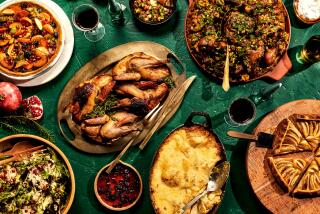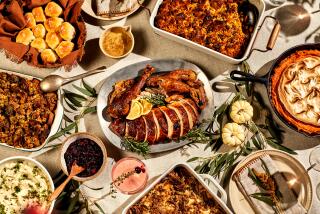Thanksgiving turkey 101: Trussing, roasting, carving and more tips
The big day is almost here. Weâve compiled a last-minute resource of common turkey tips to help you out as you tackle the big bird, covering everything from trussing to carving and presentation this Thanksgiving.
Weâve shot many of the tips on video, such as Food editor Russ Parsonsâ helpful tips on dry-brining and roasting the turkey, above. Youâll find links to the videos along with helpful written tips below.
Craving more? Check out our handy holiday recipes and cooking tips page to help you out with your Thanksgiving planning. Not only do we cover familiar holiday dishes, we share tips and tricks to save you time and energy during this busy time of year. And you can find all your Thanksgiving recipe needs in our California Cookbook.
If you have any tips or questions youâd like me to explore, leave a comment or shoot me an email at [email protected].
TRUSSING
If youâve ever roasted a whole chicken for dinner, or tackled the big task of roasting the turkey for Thanksgiving, you probably know the importance of tying up the bird, or âtrussing.â
Trussing tightens the shape of the bird to give it that appealing shape: forcing the breast plate out, keeping the legs crossed at the ends. Without trussing, the bird would just lie there, limp and sloppy-looking.
You can have your butcher truss a bird for you, but itâs just as easy to do at home. Check out the video above for a quick step-by-step.
CHECKING FOR DONENESS
Youâre roasting your turkey in the oven, and while it may look like itâs ready to eat, you have no idea if itâs actually done. What do you do?
Thereâs only one foolproof way to check for proper doneness, and that is using a thermometer. Turkey, like chicken, is done when a thermometer reaches at least 165 degrees. Slide the thermometer into the hip meat, in between the leg and breast; make sure the thermometer does not touch the bone, as this will give an artificially high reading (the bones heat faster than the meat).
Likewise, if the meat is done, the joints should twist easily. Additionally, properly cooked turkey meat should feel firm when pressed, and the juices are often clear.
But what happens if we still see pink? Color isnât always a good indication of doneness. Turkey, and other poultry, can be done even when it is still a little pink.
This is especially true with young birds whose bones are still porous -- since the bones havenât completely calcified and hardened, pigment can seep through to the surrounding area, coloring the meat and liquids, and causing the bones themselves to darken.
And while the meat should not be overly pink or ârubberyâ-feeling (a good indication it still needs to cook), it meat might also remain a little pink even after cooking due to the hemoglobin in the tissue.
Invest in a thermometer. Itâs the one foolproof way to safely check for doneness.
PRESENTATION
Parade the bird early. No matter how beautiful your turkey looks when it comes out of the oven, it only takes a few minutes before the taut skin begins to wrinkle and your proud bird begins to look like a large raisin with legs. Proudly parade your bird to the guests right out of the oven, when itâs at its most spectacular. Then keep it in the kitchen until youâre ready to serve, and carve the turkey before presenting it again at the table.
CARVING
Most of us only carve a turkey once, maybe twice, a year. If youâre feeling a bit rusty, check out Russ Parsonsâ video. He also offers these helpful tips:
âUse a carving knife that is stiff and sharp enough to cut through the birdâs many joints. Work on a cutting board thatâs large enough to hold everything comfortably, preferably one with a groove around the outside to catch the juices.
âAnd remember that even expert carvers need a well-cooked turkey to do their best. A bird that has been overcooked will be dry and will crumble under the knife. An undercooked turkey will be a wrestling match as you try to flex its joints.
âAlso, be sure to allow at least a half hour of ârestingâ after removing the turkey from the oven, to allow the meat to reabsorb the juices. Cover the bird loosely with aluminum foil to keep it warm.
âStart with the wings. Cut a deep slit through the base of the breast just above the wingâs âshoulderâ joint. Flex the wing backward and cut through the joint. Hold the wing upright and cut straight down through the âelbowâ joint to divide the wing in half. Repeat with the other side.
âNow remove the legs. Cut through the skin between the breast and the leg. Flex the leg down to pop free the âhipâ joint and then cut around it to separate the leg completely. Hold the leg upright by the drumstick and cut straight down through the âkneeâ joint to divide the leg in half. Use a carving fork to pin the thigh to the carving board and cut away as much of the dark meat as you can in long clean slices. Repeat with the other side.
âCarve the breasts. Feel for the keel bone, the long, sharp bone that runs down the center of the breast. Cut straight down on one side until you feel the ribs underneath. Use the carving knife and fork to follow the bones, lifting the breast off in one piece. Now carve the breast in cross-wise slices. Repeat with the other side.â
PLATING
Arrange the platter carefully. After youâve carved the turkey, arrange it on the platter so that plenty of browned skin is showing, not just gray and beige meat. And if your turkey is a bit dry (this has happened to all of us), baste the slices with broth or thinned gravy to moisten before serving.
Love cooking as much as I do? Follow me @noellecarter
More to Read
Eat your way across L.A.
Get our weekly Tasting Notes newsletter for reviews, news and more.
You may occasionally receive promotional content from the Los Angeles Times.








